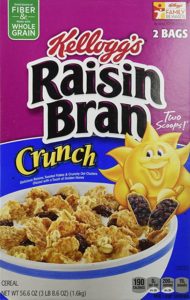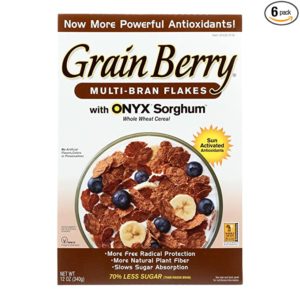I like to eat cereal for breakfast. It is easy, quick, and gets my engine started for the day. Unfortunately, I have lately had a hard time finding a cereal that matches my dietary needs.
 I started with Weight Watchers over 20 years ago. Weight Watchers helped me lose 40 pounds with a low-fat diet. Most cereals are low in fat and my favorites were Raisin Bran Crunch and Special K Red Berries. I gradually gained about 20 of those pounds back, but it was a weight that was easy to maintain.
I started with Weight Watchers over 20 years ago. Weight Watchers helped me lose 40 pounds with a low-fat diet. Most cereals are low in fat and my favorites were Raisin Bran Crunch and Special K Red Berries. I gradually gained about 20 of those pounds back, but it was a weight that was easy to maintain.
When Tom and I retired, eight years ago, we had to go to a low-salt diet. Our age-related blood pressure had been rising for a while and it was either go low-sodium or go on medication. We chose low-sodium and have done a pretty good job reading labels. The trick to eating low-sodium is to go with unprocessed foods. We eat lots of salads and sandwiches and avoid packaged foods that tend to be high in sodium. We found Boar’s Head deli meat which carries some low-sodium products. Breakfast cereals are not high in sodium, so I didn’t have to change cereals.
When I was diagnosed with metabolic syndrome, however, I had to revise my eating again. This time it was low-carbohydrate. The easiest way to manage my eating with this is to do the diabetic exchange. I think about foods in 15 carbohydrate chunks and try to limit my carbs to 150 per day. I think of it as 10 carb points each worth 15 grams. For instance, the slice of wheat bread I have for lunch is one point. My low-sodium corn chips are another point. A healthy, 2000 calorie diet will have about 250 carbohydrate grams per day. I’m not trying to eliminate carbs, just keep them to a reasonable level. And I want to eliminate added sugar as much as possible.
If I spend three carb points per meal, which seems to be the least I can do without feeling like I’m starving, then I have one point left over for a cookie or other snack. Following these guidelines I’ve lost 20 pounds and been able to maintain my weight for the last six months. I also lowered my A1C so I’m no longer classified as pre-diabetic. I’ve got it down with lunch and supper. But breakfast, with my cereal, has been a problem.
Most breakfast cereals are made of grains with added sugars. I’ve spent a lot of time looking at nutrition information since I was diagnosed. For instance, my all-time favorite cereal, Raisin Bran Crunch has 46 carbohydrate grams and 11 grams of added sugar. That’s a lot of added sugar! Special K Red Berries is only 34 carbohydrate grams but it still has 10 grams of added sugar.
 I decided I needed to find a breakfast cereal that has less than 30 grams of carbohydrates and little added sugar. I’m trying to get away from needing things to taste sweet. After a lot of label reading and trying some different cereals, my go-to cereal is now Grain Berry Multi-Bran Flakes. They have 33 grams of carbohydrates per serving but only 5 grams of added sugar. Another benefit is I can usually find it on the shelves of my local grocery store. I slice up a banana or add some blueberries and I’m good to go.
I decided I needed to find a breakfast cereal that has less than 30 grams of carbohydrates and little added sugar. I’m trying to get away from needing things to taste sweet. After a lot of label reading and trying some different cereals, my go-to cereal is now Grain Berry Multi-Bran Flakes. They have 33 grams of carbohydrates per serving but only 5 grams of added sugar. Another benefit is I can usually find it on the shelves of my local grocery store. I slice up a banana or add some blueberries and I’m good to go.
A couple of weeks ago Kroger was out of Grain Berry Multi-Bran Flakes so I tried a Keto cereal. Keto generally means low in carbs. It was Keto-Friendly Incredi-Bowl Frosted Flakes. They were only 14 grams of carbohydrates and less than one gram of added sugar. Perfect, right? They tasted like artificially sweetened Styrofoam. I forced myself to finish the box, but never again. I didn’t recognize any of the ingredients. None of them seemed “natural.”
Lately I’ve been seeing ads on television for Magic Spoon Cereals. They all have 15 grams of carbohydrates and no added sugar, but they do have artificial sweetener. And the flavors all look like kids’ cereals. I may try some of them if I can find them at the grocery store.
I appreciate that there are so many choices available at the grocery store these days. With my low-fat, low-sodium, low-carbohydrate diet, some days I feel like I am lucky to find anything I can eat. Good thing I love fruits and vegetables!
